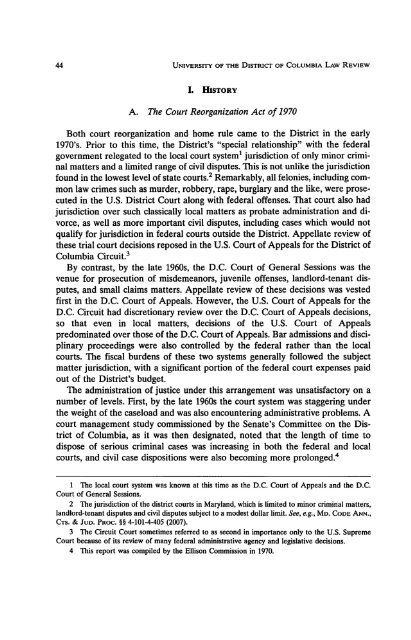Download Electronic Version - UDC Law Review
Download Electronic Version - UDC Law Review
Download Electronic Version - UDC Law Review
Create successful ePaper yourself
Turn your PDF publications into a flip-book with our unique Google optimized e-Paper software.
44 UNIVERSITY OF THE DISTRICf OF COLUMBIA LAW REVIEW<br />
I. HISTORY<br />
A. The Court Reorganization Act of 1970<br />
Both court reorganization and home rule came to the District in the early<br />
1970's. Prior to this time, the District's "special relationship" with the federal<br />
government relegated to the local court system! jurisdiction of only minor criminal<br />
matters and a limited range of civil disputes. This is not unlike the jurisdiction<br />
found in the lowest level of state courts. 2 Remarkably, all felonies, including common<br />
law crimes such as murder, robbery, rape, burglary and the like, were prosecuted<br />
in the U.S. District Court along with federal offenses. That court also had<br />
jurisdiction over such classically local matters as probate administration and divorce,<br />
as well as more important civil disputes, including cases which would not<br />
qualify for jurisdiction in federal courts outside the District. Appellate review of<br />
these trial court decisions reposed in the U.S. Court of Appeals for the District of<br />
Columbia Circuit. 3<br />
By contrast, by the late 1960s, the D.C. Court of General Sessions was the<br />
venue for prosecution of misdemeanors, juvenile offenses, landlord-tenant disputes,<br />
and small claims matters. Appellate review of these decisions was vested<br />
first in the D.C. Court of Appeals. However, the U.S. Court of Appeals for the<br />
D.C. Circuit had discretionary review over the D.C. Court of Appeals decisions,<br />
so that even in local matters, decisions of the U.S. Court of Appeals<br />
predominated over those of the D.C. Court of Appeals. Bar admissions and disciplinary<br />
proceedings were also controlled by the federal rather than the local<br />
courts. The fiscal burdens of these two systems generally followed the subject<br />
matter jurisdiction, with a significant portion of the federal court expenses paid<br />
out of the District's budget.<br />
The administration of justice under this arrangement was unsatisfactory on a<br />
number of levels. First, by the late 1960s the court system was staggering under<br />
the weight of the caseload and was also encountering administrative problems. A<br />
court management study commissioned by the Senate's Committee on the District<br />
of Columbia, as it was then designated, noted that the length of time to<br />
dispose of serious criminal cases was increasing in both the federal and local<br />
courts, and civil case dispositions were also becoming more prolonged. 4<br />
1 The local court system was known at this time as the D.C. Court of Appeals and the D.C.<br />
Court of General Sessions.<br />
2 The jurisdiction of the district courts in Maryland, which is limited to minor criminal matters,<br />
landlord-tenant disputes and civil disputes subject to a modest dollar limit. See, e.g., MD. CODE ANN.,<br />
Crs. & JUD. PROC. §§ 4-101-4-405 (2007).<br />
3 The Circuit Court sometimes referred to as second in importance only to the U.S. Supreme<br />
Court because of its review of many federal administrative agency and legislative decisions.<br />
4 This report was compiled by the Ellison Commission in 1970.














